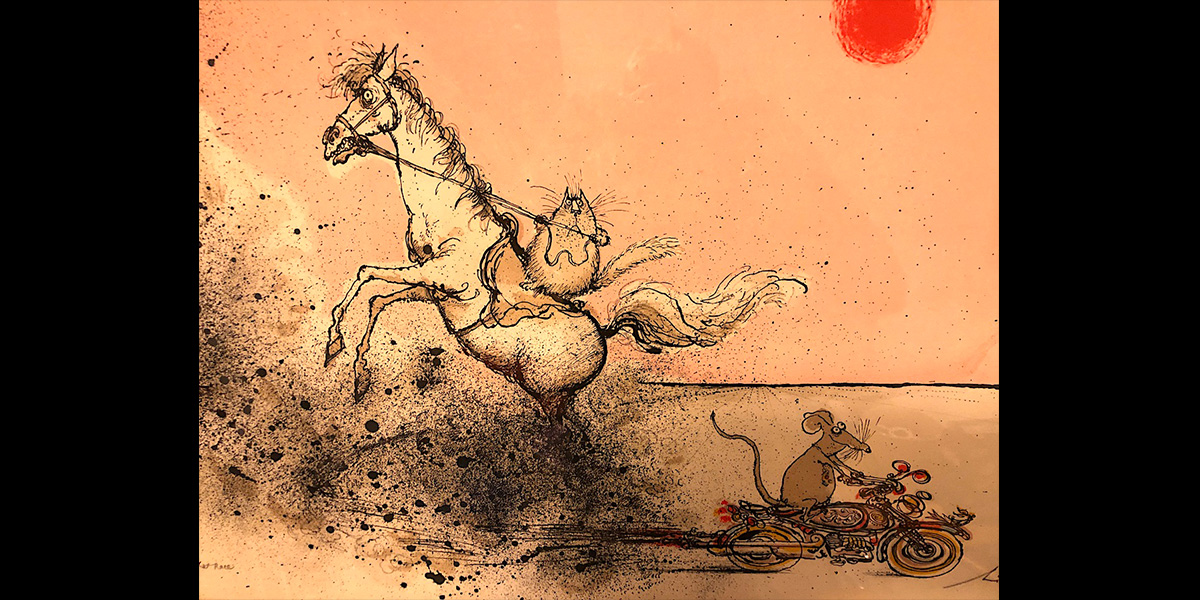Tributes have been pouring in for the British artist/cartoonist Ronald Searle who has died in the South of France. The artist is best remembered for his witty illustrations for the St Trinian’s series of books . Searle,was a Cambridge native and passed away on 30th December aged 91 at a hospital near his home in Draguignan, in the south-eastern Var region of France.
The family stated “Ronald William Fordham Searle, born 3 March 1920, passed away peacefully in his sleep with his children, Kate and John, and his grandson, Daniel, beside him on 30 December 2011 in Draguignan, France, after a short illness. “He requested a private cremation with no fuss and no flowers.” Born in 1920, Searle was the son of a railwayman, and educated at the Boy’s Central School, Cambridge.He began his work as a solicitor’s clerk, and soon left to study art at the Cambridge Technical College and School of Art (1936-1939). His first professional work was published in the Cambridge Daily News, now Cambridge News. Mr Searle said of his own student days: “At the Cambridge School of Art it was drummed into us that we should not move, eat, drink or sleep without a sketchbook in the hand. Consequently, the habit of looking and drawing became as natural as breathing.” He was presented with an Honorary Doctorate of the University by Anglia Ruskin University and he put his name to The Ronald Searle Award for Creativity in the Arts.
In January 1942, he was stationed in Singapore. After a month of fighting in Malaya, Singapore fell to the Japanese, and he was taken prisoner along with his cousin Tom Fordham Searle. He spent the rest of the war a prisoner, first in Changi Prison and then in the Kwai jungle, working on the Siam-Burma Death Railway.
The brutal camp conditions were documented by Searle in a series of drawings that he hid under the mattresses of prisoners dying of cholera. Liberated late in 1945, Searle returned to England where he published several of the surviving drawings in fellow prisoner Russell Braddon’s The Naked Island. Most of these drawings appear in his 1986 book, Ronald Searle: To the Kwai and Back, War Drawings 1939-1945. At least one of the drawings is on display at the Changi Museum and Chapel, Singapore, but the majority of these original drawings, approximately 300, are in the permanent collection of the Imperial War Museum, London, along with the works of other POW artists. The best known of these are Jack Bridger Chalker, Philip Meninsky and Ashley George Old.
He married the journalist Kaye Webb in 1947; they had twins, Kate and Johnny. Searle produced an extraordinary volume of work during the 1950s, including drawings for Life, Holiday and Punch. His cartoons appeared in The New Yorker, the Sunday Express and the News Chronicle. He compiled more St Trinian’s books, which were based on his sister’s school and other girls’ schools in Cambridge. He collaborated with Geoffrey Willans on the Molesworth books (Down With Skool!, 1953, and How to be Topp, 1954), and with Alex Atkinson on travel books. In addition to advertisements and posters, Searle drew the title backgrounds of the Sidney Gilliat and Frank Launder film The Happiest Days of Your Life.
In 1961, he moved to Paris, leaving his family and later marrying Monica Koenig, theater designer and creator of necklaces. In France he worked more on reportage for Life and Holiday and less on cartoons. He also continued to work in a broad range of media and created books (including his well-known cat books), animated films and sculpture for commemorative medals, both for the French Mint and the British Art Medal Society. Searle did a considerable amount of designing for the cinema, and in 1965, he completed the opening, intermission and closing credits for the comedy film Those Magnificent Men in Their Flying Machines. In 1975, the full-length cartoon Dick Deadeye was released. Animated by a number of artists both British and French, it is considered by some to be his greatest achievement, although Searle himself detested the result. After 1975, Searle and his wife lived and worked in the mountains of Haute Provence.
Searle received much recognition for his work, especially in America, including the National Cartoonists Society’s Advertising and Illustration Award in 1959 and 1965, the Reuben Award in 1960, their Illustration Award in 1980 and their Advertising Award in 1986 and 1987. Searle was appointed Commander of the Order of the British Empire in 2004. In 2007, he was decorated with one of France’s highest awards, the Chevalier de la Légion d’honneur, and in 2009, he received the German Order of Merit.
Photo: Ronald Searle Rat Race Courtesy Artlyst

